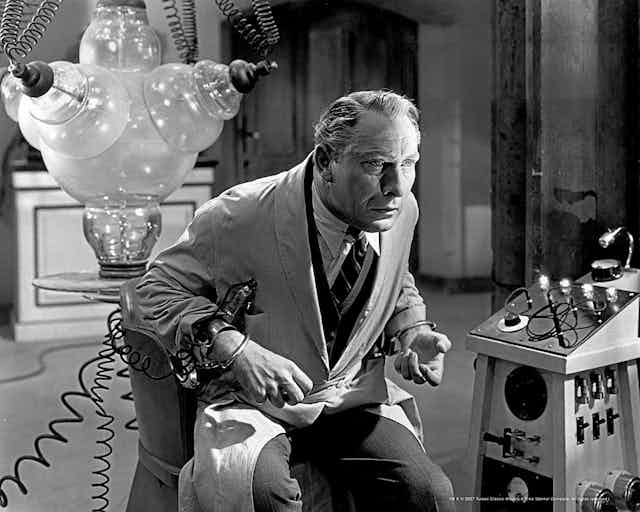The future in science fiction is often presented in a dystopian setting. Certainly films such as Ridley Scott’s Blade Runner, Andrew Niccol’s Gattaca and Alfonso Cuarón’s Children of Men follow this pattern. But why?
A dystopia is an imaginary world deliberately conceived as being worse than our own; a utopian one conceived as better. But many science fiction worlds are neither better nor worse – merely different.
An obvious example is provided by George Lucas’s six Star Wars films, each set a long time ago in a galaxy far, far away. That galaxy is essentially neither better nor worse than our own, but certainly different (in space people can, it seems, hear you scream).

Ridley Scott has directed two other science fiction films besides Blade Runner: [Alien](http://en.wikipedia.org/wiki/Alien_(franchise) and Prometheus, neither of which is truly dystopian or utopian. Their world is essentially a logical extension of our own, albeit with better-developed technologies and - the crucial difference - formidably hostile alien species.
Indeed, much science fiction cinema is actually set in a world identical to our own, except for the presence of some distinctive fictional invention and its often-eccentric or emotionally tortured inventor.
Notable examples include the various film adaptations of:
- Mary Shelley’s Frankenstein
- Robert Louis Stevenson’s The Strange Case of Dr Jekyll and Mr Hyde
- HG Wells’s The Time Machine.
Even Robert Zemeckis’ Back to the Future and its sequels fit this pattern very nicely.
Science fiction cinema can sometimes be positively utopian. The most famous British science fiction film of the 1930s, William Cameron Menzies’ Things to Come, was a utopia, at least in its eventual resolution.
More contemporary examples of utopian science fiction clearly include the 11 Star Trek films. The world of Star Trek - the United Federation of Planets, Star Fleet, even the USS Enterprise itself - is indisputably a utopia. It is set at a time when technological innovation has effectively solved the practical problems confounding humanity.

People travel the galaxy in star-ships, their food and drink supplied by replicators, their fantasies enacted out and fulfilled in holodecks. Their collective social life appears similarly unproblematic.
On Earth, poverty, inequality and social conflict have been eliminated, so that both genders, all races and various sexualities are equal. In the wider universe, humanity lives at peace with neighbouring alien species in the Federation.
What applies to science fiction cinema also applies to science fiction literature. Science fiction novels, plays and short stories might well be utopian, for example:
- Edward Bellamy’s Looking Backward
- Ursula K. Le Guin’s The Dispossessed
- Kim Stanley Robinson’s Pacific Edge
- Iain M. Banks’ series of eight [Culture](http://en.wikipedia.org/wiki/Culture_(fictional_civilisation) novels
They have perhaps more often been dystopian, for example:
- Karel Capek’s R.U.R
- Yevgeny Zamyatin’s [Mi](http://en.wikipedia.org/wiki/We_(novel)
- Aldous Huxley’s Brave New World
- George Orwell’s Nineteen Eighty-Four
- Ray Bradbury’s Fahrenheit 451
- Margaret Atwood’s The Handmaid’s Tale
More commonly, however, they have been neither. Not one of the 54 novels Jules Verne published in his lifetime was a utopia or dystopia. Of the eight novels in Victor Gollancz’s The Scientific Romances of H.G. Wells, only In the Days of the Comet and Men Like Gods were utopias. The first of these – simultaneously both utopia and dystopia – was dropped from the Seven Science Fiction Novels collection published in the United States.

Yet, for all these careful qualifications and amendments, it remains true that much science fiction - and often the most interesting examples, in both literature and the cinema - is indeed dystopian. There are, no doubt, many reasons for this. But the most important is that utopia is fundamentally boring, since nothing much can happen in a place where nothing much is wrong.
Utopian writers and film directors have come up with a whole series of devices designed to circumvent this boredom, among them:
- the sexual romance within utopia (William Morris’s News from Nowhere and Bellamy’s Looking Backward both adopted this device, which has been taken up by the vast majority of subsequent utopias)
- the distant view of utopia from its extremities (in both Banks’s Culture novels and the Star Trek films the action typically takes place on the edges of the utopia)
- the external threat to utopia (again, characteristic of both the Culture novels and the Star Trek films).
But the sheer persistence of these utopian strategies for discounting boredom suggests how powerful a problem it might actually represent.
By contrast, dystopias are rarely charged with boredom, since their stock in trade of human beastliness remains oddly captivating to our conventional post-lapsarian sensibilities. This is too negative a conclusion, nonetheless, since dystopia also often has a deliberately positive function.
The more serious of the worse worlds of dystopian fiction typically take as their political or moral purpose the intention to warn against undesirable likely future developments.
Dystopia goes in and out of fashion, but it was almost certainly at its most influential in Europe during the first half of the 20th century – that is, in a time and place in which there were two dreadful wars, the Great Depression, Stalinism and Fascism. In short, a time and place with much to be warned against.
If dystopia has once again become fashionable in film and literature, it’s almost certainly because we too now have much to be warned against.

